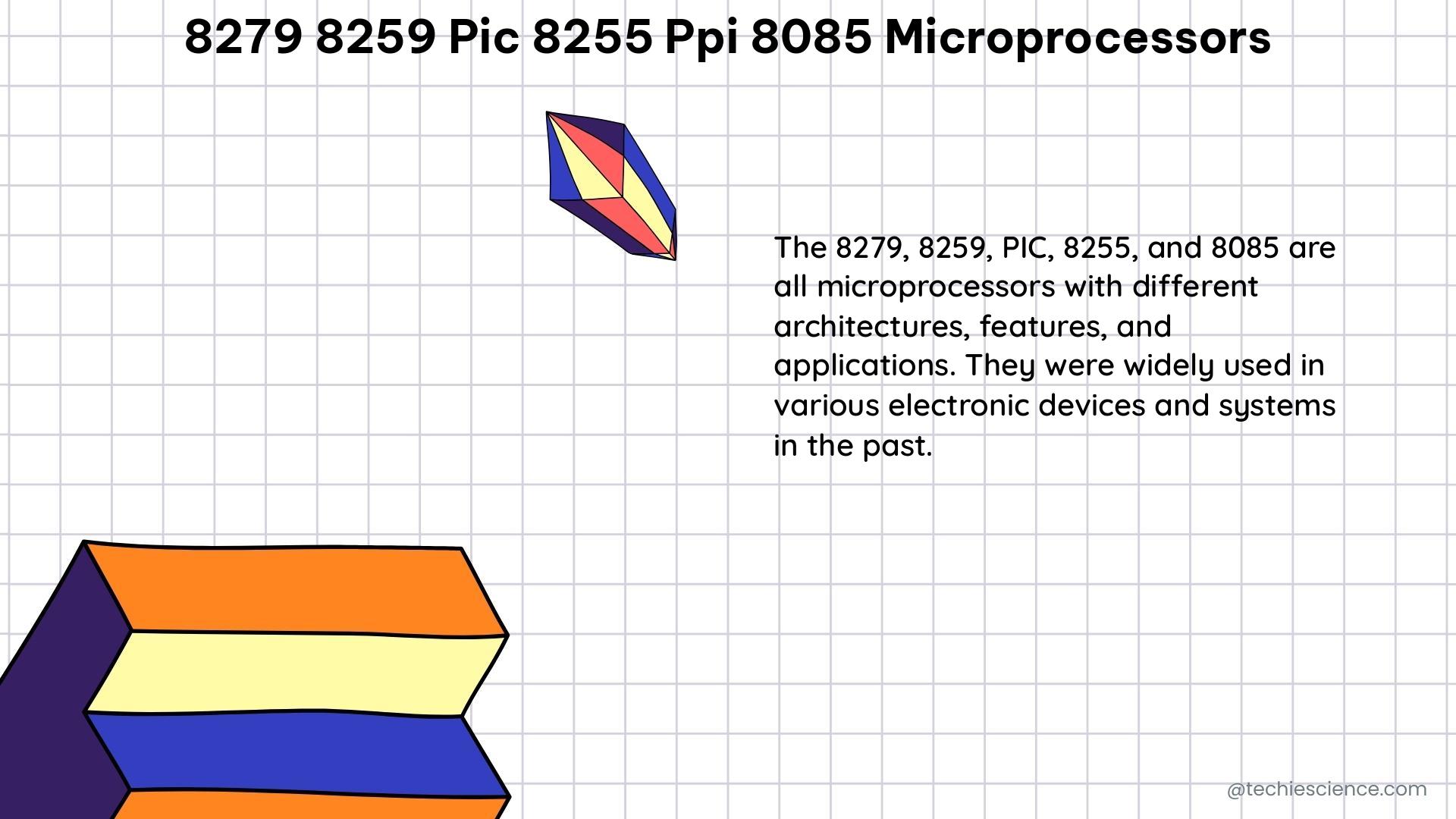The 8279, 8259, and 8255 are programmable peripheral devices that play a crucial role in 8085-based microprocessor systems. These devices provide essential functionalities such as data transfer, interrupt management, and keyboard/display interfacing, making them indispensable components in the design and implementation of embedded systems.
8255 Programmable Peripheral Interface (PPI)
The 8255 Programmable Peripheral Interface (PPI) is a versatile, general-purpose programmable device used for data transfer between the processor and I/O devices. It features three programmable I/O ports, designated as PA, PB, and PC, each with a resolution of 8 bits. The 8255 PPI can be programmed to operate in different modes, allowing for flexible and customizable data transfer operations.
Key Features of the 8255 PPI
- Programmable I/O Ports: The 8255 PPI has three 8-bit I/O ports (PA, PB, and PC) that can be individually programmed to operate in different modes, such as input, output, or bidirectional.
- Flexible Programming Modes: The 8255 PPI can be programmed to operate in one of three modes: Mode 0 (basic input/output), Mode 1 (strobed input/output), and Mode 2 (bidirectional bus).
- Interrupt Capability: The 8255 PPI can generate interrupt requests to the processor, allowing for efficient data transfer and synchronization with external devices.
- Control Register: The 8255 PPI has a control register that allows for the configuration and control of the I/O ports, including the selection of operating modes and interrupt settings.
- Power Consumption: The 8255 PPI has a low power consumption, making it suitable for use in battery-powered or energy-efficient systems.
Programming the 8255 PPI
To program the 8255 PPI, the following steps are typically followed:
- Initialize the Control Word: The control word is written to the control register to configure the operating mode, port directions, and interrupt settings.
- Set Port Directions: The I/O ports (PA, PB, and PC) are configured as either input or output, depending on the application requirements.
- Perform Data Transfer: Data is transferred between the processor and the I/O devices using the configured I/O ports.
- Handle Interrupts (if enabled): If the 8255 PPI is configured to generate interrupt requests, the interrupt service routine (ISR) is executed to handle the data transfer or other events.
The 8255 PPI is widely used in 8085-based systems for a variety of applications, such as interfacing with keyboards, displays, sensors, and other peripheral devices.
8259 Programmable Interrupt Controller (PIC)

The 8259 Programmable Interrupt Controller (PIC) is a crucial component in 8085-based systems, responsible for managing and prioritizing interrupt requests from various peripheral devices. It provides a flexible and efficient way to handle interrupts, allowing the processor to focus on its primary tasks without being overwhelmed by constant interrupt handling.
Key Features of the 8259 PIC
- Interrupt Request Lines: The 8259 PIC has 8 interrupt request (IRQ) lines, each of which can be connected to a different peripheral device.
- Programmable Interrupt Priorities: The 8259 PIC allows for the programming of interrupt priorities, ensuring that critical interrupts are handled first.
- Interrupt Masking: The 8259 PIC provides the ability to mask or disable specific interrupt request lines, allowing the processor to focus on the most important tasks.
- Interrupt Vectoring: The 8259 PIC generates an interrupt vector, which is used by the processor to jump to the appropriate interrupt service routine (ISR).
- Cascading Capability: Multiple 8259 PICs can be cascaded to support a larger number of interrupt request lines, enabling more complex interrupt management in larger systems.
- Programmable Operating Modes: The 8259 PIC can be programmed to operate in different modes, such as the 8086 mode, 8080/8085 mode, and special fully nested mode, depending on the system requirements.
Programming the 8259 PIC
To program the 8259 PIC, the following steps are typically followed:
- Initialize the Interrupt Controller: The 8259 PIC is initialized by writing the Initialization Command Word (ICW1) to the control register.
- Set Interrupt Priorities: The Interrupt Mask Register (IMR) is programmed to set the priorities of the interrupt request lines.
- Enable Interrupts: The 8259 PIC is enabled to start accepting and processing interrupt requests.
- Handle Interrupt Requests: When an interrupt request is received, the 8259 PIC generates an interrupt vector, which the processor uses to jump to the appropriate interrupt service routine (ISR).
- Manage Interrupt Masking: The Interrupt Mask Register (IMR) can be used to mask or unmask specific interrupt request lines as needed.
The 8259 PIC is essential in 8085-based systems, as it allows for efficient and prioritized handling of interrupt requests from various peripheral devices, ensuring that the processor can respond to critical events in a timely manner.
8279 Programmable Keyboard/Display Interface
The 8279 Programmable Keyboard/Display Interface is a specialized device designed to simplify the interfacing of keyboards and displays with 8085-based microprocessor systems. It provides a standardized and programmable way to handle keyboard input and display output, reducing the complexity of the overall system design.
Key Features of the 8279 Programmable Keyboard/Display Interface
- Keyboard Interfacing: The 8279 can interface with a variety of keyboard types, including matrix-encoded keyboards, scanned keyboards, and encoded keyboards.
- Display Interfacing: The 8279 can interface with various display types, including 7-segment displays, hexadecimal displays, and alphanumeric displays.
- Programmable Operating Modes: The 8279 can be programmed to operate in different modes, such as keyboard mode, display mode, and sensor mode, depending on the application requirements.
- Interrupt Generation: The 8279 can generate interrupt requests to the processor, allowing for efficient handling of keyboard input and display updates.
- Programmable Scan Rates: The 8279 allows for the programming of keyboard and display scan rates, enabling the system to adapt to different input and output devices.
- FIFO Buffers: The 8279 includes First-In-First-Out (FIFO) buffers for both keyboard input and display output, allowing for efficient data handling and reducing the burden on the processor.
Programming the 8279 Programmable Keyboard/Display Interface
To program the 8279 Programmable Keyboard/Display Interface, the following steps are typically followed:
- Initialize the 8279: The 8279 is initialized by writing the appropriate command words to the control register, configuring the operating mode, scan rates, and other parameters.
- Set up Keyboard Interfacing: The keyboard interface is configured by programming the 8279 to handle the specific keyboard type and encoding scheme.
- Set up Display Interfacing: The display interface is configured by programming the 8279 to handle the specific display type and output format.
- Handle Keyboard Input: When a key is pressed on the keyboard, the 8279 generates an interrupt request, and the processor reads the key data from the FIFO buffer.
- Handle Display Output: The processor writes data to the 8279’s display FIFO buffer, and the 8279 updates the connected display accordingly.
The 8279 Programmable Keyboard/Display Interface simplifies the integration of keyboards and displays in 8085-based systems, allowing for efficient and flexible input/output handling.
8085 Microprocessor
The 8085 microprocessor is an 8-bit microprocessor designed and manufactured by Intel. It is a widely used and well-established processor in the field of embedded systems and industrial applications.
Key Features of the 8085 Microprocessor
- 8-bit Data Bus: The 8085 microprocessor has an 8-bit data bus, allowing it to transfer 8 bits of data at a time.
- 16-bit Address Bus: The 8085 microprocessor has a 16-bit address bus, which allows it to address up to 64KB of memory.
- Instruction Set: The 8085 microprocessor has a comprehensive instruction set, including arithmetic, logical, data transfer, and control instructions.
- Interrupt Handling: The 8085 microprocessor supports various interrupt sources, including external interrupts, software interrupts, and hardware interrupts.
- Clock Speed: The 8085 microprocessor typically operates at clock speeds ranging from 3 MHz to 6 MHz, depending on the specific implementation.
- Power Consumption: The 8085 microprocessor has a relatively low power consumption, making it suitable for use in battery-powered or energy-efficient systems.
- Peripheral Interfacing: The 8085 microprocessor can interface with a variety of peripheral devices, such as the 8255 PPI, 8259 PIC, and 8279 Programmable Keyboard/Display Interface, through its I/O ports and control signals.
Programming the 8085 Microprocessor
Programming the 8085 microprocessor typically involves the following steps:
- Instruction Set: Familiarize yourself with the 8085 instruction set, which includes arithmetic, logical, data transfer, and control instructions.
- Assembly Language: Write programs in 8085 assembly language, which provides a low-level, human-readable representation of the machine code.
- Assembler: Use an assembler tool to translate the assembly language program into machine-readable object code that can be executed by the 8085 microprocessor.
- Memory and I/O Interfacing: Understand how to interface the 8085 microprocessor with memory and I/O devices, such as the 8255 PPI, 8259 PIC, and 8279 Programmable Keyboard/Display Interface.
- Interrupt Handling: Implement interrupt handling routines to respond to external events and manage the flow of execution in the 8085-based system.
- Debugging: Use debugging tools, such as emulators and simulators, to test and debug your 8085 programs, ensuring their correct operation.
The 8085 microprocessor is a versatile and widely used processor in the field of embedded systems and industrial applications, and its integration with the 8255 PPI, 8259 PIC, and 8279 Programmable Keyboard/Display Interface provides a powerful and flexible platform for a wide range of applications.
Conclusion
The 8279, 8259, and 8255 programmable peripheral devices, along with the 8085 microprocessor, form a comprehensive and powerful ecosystem for the design and implementation of 8085-based embedded systems. By understanding the key features and programming techniques of these components, electronics students and engineers can develop robust and efficient solutions for a wide range of applications, from industrial automation to consumer electronics.
References
- Programmable Peripheral Devices
- Microprocessor Unit – Memory Interfacing & IO Interfacing
- Programmable Peripheral Interface (8255)
- 8259 PIC Help
- 8259 PIC Microprocessor

Hi, I am Soumali Bhattacharya. I have done Master’s in Electronics.
I am currently invested in the field of Electronics and communication.
My articles are focused on the major areas of core electronics in a very simple yet informative approach.
I am a vivid learner and try to keep myself updated with all the latest technologies in the field of Electronics domains.
Let’s connect through LinkedIn –